The Death of the Slide Rule
Bill Terry, a graduate of the University of Santa Clara, joined HP in 1957 and held positions
in training, sales and corporate marketing before being named marketing manager at
Colorado Springs in 1965. Two years later he became the division's general manager.
By the beginning of 1972, Bill Terry was President of the HP Instrument Group,
after having headed the Data Products Group since 1970.

Some thirty years later, in his interview for the video "ORIGINS", Bill Terry recalled:
"One day the phone rang and Hewlett says, "We've got this calculator going on at HP labs." So I went up and talked to Bill and he gave me the market research report that suggested we shouldn't do it. It's going to cost twenty times more than a slide rule !
Then, Bill said, "I WANT one of these things."
That was it. With initial estimate cost of $350 to build the new scientific calculator, it was almost double the average price of standard calculators currently on the market in 1972. The results of the market research ordered by Bill Hewlett weren't heartening. The most optimistic forecast was in the range of 1,000 units per month. But Hewlett had already decided to spend HP's talent on the project, and it was its riskiest and bravest business decision. Immediately after its introduction, sales of the HP 35 went through 10,000 per month, climbing almost straight up.
John Minck
comment in its "Inside HP" narrative:
"The price was a stroke of genius, because the $395 was easily within the reach of every engineer, not just managers. It was not only a prestigious personal possession, but an amazing drudgery beater. It made better engineers, and it made them faster and more efficient." . . .
"The HP 35 was probably HP's number one product winner of its 6 business decades. It captivated our technical customers. It raised HP's already high prestige. It brought untold computing power to the fingertips of the common engineer, and they worshiped HP for the innovation. Finally, it sparked a long succession of more and more powerful machines, the magnetic-strip programmable HP 65, financial versions, and many more." . . .
"I personally believe that the HP 35 changed our HP history. It most certainly launched HP into the "consumer" market, even though this particular product had a professional (engineering/consumer) focus. HP later introduced other powerful consumer machines, some years before competitive $10 units began showing up in drugstores. The line of successful pocket calculators also reinforced HP's dominance in desktop computer technologies, such as the follow-on HP 9810 and 9830, and later the highly-programmable HP 9826 and 9836."
"These three paragraphs are just an excerpt from a more complete summary of the role of the LED display in the HP-35 story as related by John Minck in his "Inside HP Narrative." Certainly there were many enthusiastic influences to the final HP-35, starting with Bill Hewlett, who wanted the engineering power of the HP 9100A desktop in his shirt pocket. And Hewlett had challenged Dave Cochran to make that happen. Minck's memo of Jan 27, 1970 contained some recommendations for realizing the final product.

The HP-35 Story - From John Minck "Inside HP Narrative"
 |
From MEASURE Magazine, June 1972 Article, "A Superstar is Born"
Courtesy of the Hewlett Packard Company |
A Superstar is Born !
Another indicator of the upheaval generated by the HP 35 introduction could be gauged by reading the June 1972 issue of MEASURE Magazine. The article "A Superstar is Born!" begins as follows:
""What's giving chief executive officers new status? What kind of machine is ·it that could cause an otherwise stable engineer to become "insanely jealous"? Why are highly skilled technical people saying things like "fabulous;' and "fantastic;' and "gee whiz!" or-"the design accomplishment of the century:' Why are HP phones so extraordinarily busy at Cupertino, and Rockville, and Houston, and Paris? Why is HP receiving fan letters from science-fiction clubs? What's the talk of the campus at California Institute of Technology and Princeton? And what could prompt a field engineer to say, "Any statement you care to make about it in the way of
praise will probably be an understatement:"
"So ... welcome to the wonderful world of the HP-35 pocket calculator. For a company that has always dealt soberly with the business of its business, albeit with style and invention, Hewlett-Packard has discovered a whole new giddy interface, thanks to the Model 35. For not only is the 35 a runaway best seller (a slight misnomer because as yet, there are no real competitors on the scene), but it is also a novel experience in terms of marketing and selling.""
By the time the HP-35 Scientific Calculator was discontinued in 1975, just three and one-half years after its introduction, more than 300,000 had been sold.
Honoring the achievements of HP and the HP-35 team.
On Tuesday, April 14, 2009, the IEEE recognized the HP 35, world’s first pocket scientific calculator, as a milestone. The original design team present received awards for their participation. On the photo below, made by Steve Leibson, from left to right: Rich Marconi, France Rode, Lew Terman, Dave Cochran, Donna Whitney (representing husband, Tom Whitney), Tom Osborne, Ken Peterson, Chung Tung, Dick Osgood, Bill Misson.
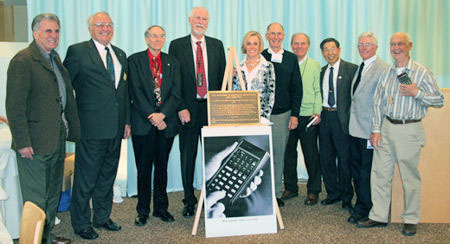 |
HP-35 team members at the IEEE HP-35 Milestone Award event
Courtesy of Steve Leibson |
Dave Cochran, Product Manager of the Original HP-35
Dave Cochran, fourth from the left on the photo above, was the product manager of the original HP-35. Dave was HP Laboratories' top algorithm designer and microprogrammer, having performed those functions for both the HP 9100A and HP-35 calculators.
Today, in 2010, Dave gives us is approval for publishing one of his recent writing about the HP-35 design:

The HP-35 Design, A Case Study in Innovation
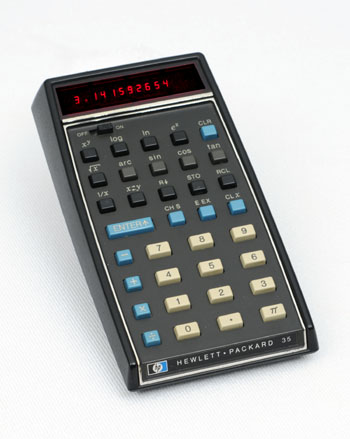 |
The HP 35
|
The HP 35, World's First
Scientific Pocket Calculator
At its introduction in January 1972, compared to the usual 4-operation calculators of the time, the HP 35 offered the following improvements:
* A broad variety of computations: logarithmic, powers, direct and inverse trigonometric functions.
* A way to override the parenthesis scheme and to be able to store intermediate results in a calculation within a 4 register operational stack.
* The capacity to store partial results into a memory register for later use in a problem.
* A 200 decade range to display values in a format similar to standard scientific notation, allowing numbers between 10 E-99 to 9.999999999 10 E99 to be manipulated.
Specifications:
"Specifications" for a pocket calculator ! ?
Old habits die hard, and Hewlett Packard "spec-ed" the new pocket calculator as if it was a precision laboratory instrument.
The table on the right, published in the June 1972 issue of the Hewlett Packard Journal, details full physical characteristics, operating and storage temperature range, and typical speed/performance for the various problems which could be solved by the HP 35.
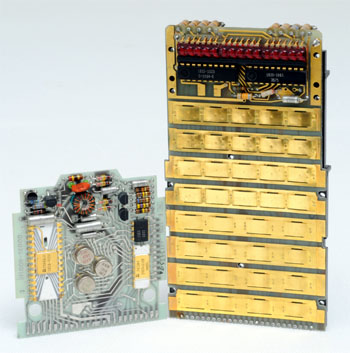 |
The HP 35 Printed-Circuit Boards
|
The HP 35 Circuitry
The HP-35 contains five MOS/LSI (metal-oxide-semiconductor, large-scale-integration) circuits : three read-only-memories (ROMs), an arithmetic and register circuit (A&R), and a control and timing circuit (C&T). The logic design was done by HP and the circuits were developed and manufactured by two outside vendors. Three custom bipolar circuits are manufactured by HP's Santa Clara Division: a two-phase clock driver, an LED anode driver/clock generator, and an LED cathode driver. ( See block diagram of the calculator on picture below )
The HP-35 is assembled on two printed circuit boards (see picture on the left). The large board contains the display, drivers and keyboard. The smaller board has all the MOS logic, clock driver, and the power supply components. Metal "humps" on the larger board are pressed down by the keys to make contact with printed traces underneath.
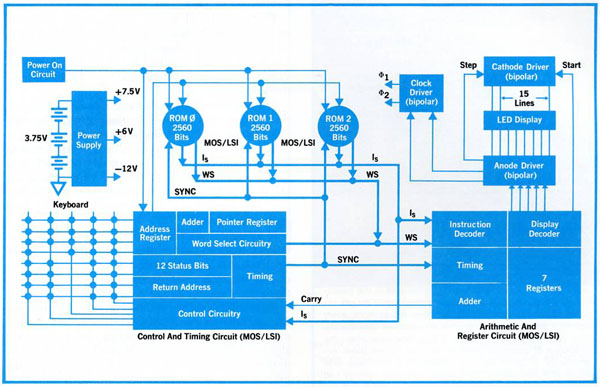 |
Block Diagram of the HP 35, from the Hewlett Packard Journal, June 1972
Courtesy of the Hewlett Packard Company |
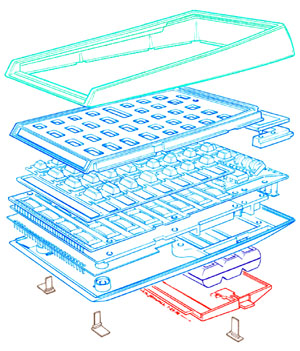 |
The HP 35 from the Hewlett Packard Journal, June 1972
Courtesy of the Hewlett Packard Company
|
Packaging the Pocket Calculator
The industrial design of the HP-35 was very unusual for Hewlett-Packard. No other product previously designed had to be Pocket-Sized.
The industrial design began with an investigation of keyboard, packaging, and overall shape concepts. Several basic form factors were studied using sketches and simple three-dimensional models.
Only a general idea of the electronic design was known at this point. Designing and packaging all necessary electrical and mechanical components into the tiny product became a tremendous challenge for electrical, mechanical, and industrial designers alike.
Every descision had to be made without any reference or comparison to previously build devices. For example, the keyboard was the most critical area of the design. The problem was to place thirty-five keys in an area approximately 2.5 inches by 4.5 inches and retain the ability to operate the keys without striking more than one at a time.
The external package was developed from a human-engineering approach, with aesthetic appeal of major importance. The sculptural wedge shape permits the calculator to be comfortably held in the palm of one hand. It also allows the product to slide easily into a pocket. The keyboard and display slope upwards for a better viewing angle in desk-top use. The texture on the case provides a non-slip surface, important when the calculator is being hand-held.
Modern Simulation of the HP 35 Pocket Calculator,
Technology evolution since the introduction of the HP 35, now allows accurate reproduction of vintage calculator functions. The example below is a JavaScript simulator written by Neil Fraser. Virtual calculator results are a faithful simulation (with the exception of some rounding errors). Both the HP-35 and the JavaScript produce rounding errors, but they do so in different situations.
Click the image below to launch it
![[Click to launch the HP-35 simulation]](hp35/hp-35.jpg)
This JavaScript simulator was written by Neil Fraser. Just click in picture above to run the simulation in a separate window. If you are using Internet Explorer you may find that the display sometimes updates quite slowly across the network. You may want to download your own copy from Neil's web site. From the home page click in "open-source software".
The HP 80, HP's Second Pocket Calculator, and 1st Financial One
The Second HP Pocket Calculator was a financial version called "HP 80". The What & Why of it's birth was explained by Bill Hewlett in a message "From the President's Desk," published in the February 1973 issue of MEASURE Magazine:
 |
Bill Hewlett in MEASURE Magazine, February 1973
Courtesy of the Hewlett Packard Company
|
From the President's Desk
"I am sure that by now most of you have seen our publicity on the new HP-80 pocket-sized calculator, designed for business and financial use. I thought you might be interested in the background of this calculator.
In March of last year we had a breakfast meeting with about 200 security analysts in New York. This was shortly after the introduction of the HP-35. On each of the breakfast tables we had an HP-35, and it was very interesting to watch the reaction of many of the financial analysts. Although they were familiar with electronics, it was evident that such key designations as sin, cos, log and ex were more a barrier to an understanding of the calculator's function than a help. The one key that was really useful for compound interest calculations (Xy) was obscure in its use. Right there and then it became evident that what was needed was a pocket-sized calculator designed specifically for the business community, and so designed that it could be readily understood by the user. As we thought more about this problem it became evident that there was a tremendous gap between the language of the user and of our development engineers. The answer was to put together a small team consisting of Bill Crowley, from the Corporate Finance Department, who had a long-standing interest in computers, and France Rode, from HP Labs, who was an expert in programming and who was soon to acquire a very good vocabularly of business terms.
These two visited a large cross section of potential business users, and from their discussions distilled a set of classic problems that they eventually shoe-horned into what is now the HP-80. After a preliminary cut on the format, Barney Oliver came in and with his typical clear thinking rearranged the keyboard to increase the logicalness of its entries and ease of organizing a particular problem. By July the problem had been defined, the circuits determined, and the program laid out for our IC suppliers. By mid-December we were in limited production, and on January 16 we announced this new product to the press.
I assure you it was very well received, and I think we can make a very valuable contribution to the business community. We have given them a device which will allow important financial decisions to be made much more quickly, and much more accurately than has previously been possible. I am sure we will all watch with interest the progress that this calculator will make for the business community.
I would like to say one thing more. Although I have mentioned three people by name, the Model 80 would not have been possible without the tremendous effort from a very wide spectrum of HP people. I visited Manufacturing's tool and die shop and was shown a single die that had taken over 700 hours to make. I visited Cupertino and saw the absolutely remarkable job that the Advanced Products Division had done in the planning for the production of this device. I visited with the marketing people and learned of their very carefully laid plans for the introduction and support of the HP-80. Like its predecessor the HP-35, the HP-80 is one of the best examples of what can be done with real teamwork."
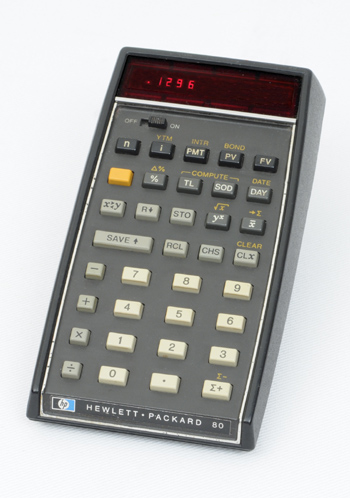 |
The HP 80
|
The HP 80,
First Business Pocket Calculator
The HP 80 was announced in the May 1973 Hewlett Packard Journal as "A Pocket-Sized Answer Machine for Business and Finance."
The HP-80 is a preprogrammed computer / calculator designed specifically for financial and business calculations. The HP-80 looks very much like the HP-35, HP's first pocket calculator, which was designed for engineering and scientific work.
In fact, the HP-80 and the HP-35 operate the same arithmetically. But the design objectives for the HP-80 were less technical and more problem oriented. Over 30 hard-wired programs were implemented in the HP-80. These programs essentially replace all of the commonly used financial tables, such as compound interest, annuities, bonds, and so on. Answers are displayed to as many as six decimal places.
 |
The HP 45
|
The HP 45,
The Slide Rule +
Introduced a short time after the HP 80, the HP 45 was an improved version of the HP 35. Sometimes nick-named the "Slide Rule +", the HP 45 was the first to have a Shift Key. It was also the first pocket calculator to have nine storage registers.
Another improvement brought by the HP 45 was a formatted display which added both fixed and scientific displays, with a choice of significant digits.
The HP 45 was also the first pocket calculator that including a timer. However, HP did not reveal it as a user feature because the timing reference, based on a simple LC circuit, was quite inaccurate. Once in timer mode, the current time was stored in the corresponding register by pressing key 1 to 9.
The HP 55, introduced in 1975, would be the first pocket calculator claiming an accurate timer function. This was made possible by a quartz crystal time reference implemented within the calculator circuitry.
The "Personal Computer": A Fully Programmable Pocket Calculator
The "Personal Computer" long before that term had become common, was the title in the May 1974 issue of the Hewlett Packard Journal. Almost entirely dedicated to the birth of the HP 65, Introduction to the first article was written by Chung C. Tung:
"AN ENGINEER OR SCIENTIST in need of an on-the-spot answer in the laboratory, a pilot making an in-flight course correction, a surveyor running a traverse in the field, a businessman estimating returns-on-investment during a conference, a physician evaluating patient data-it isn't difficult to think of everyday examples of people whose professions require certain types of calculations over and over again. Were one available, a computer or programmable calculator would obviously be of great assistance to such people. Unfortunately, you can't carry one of those around in your pocket, CAN YOU ? "
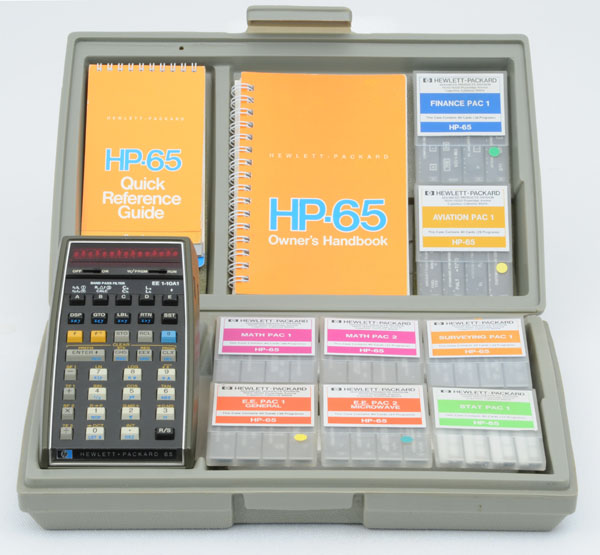 |
| The HP 65 in Original Box with User Guide and Libraries |
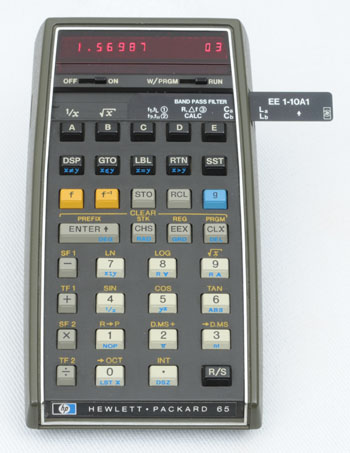 |
The HP 65
|
The HP 65, World's First
Programmable Scientific Calculator
Just 18 months after the first pocket calculator, HP introduced the HP 65 that was programmable with a magnetic card reader/writer.
Although the HP-65 was designed to operate in a logical, easy-to-learn way, it was capable of sophisticated computations. It had 51 built-in mathematical functions and data manipulation operations, a four register operational stack, nine addressable data registers, and five user-definable keys. It ran programs that had as many as 100 steps. There were two program flags and four comparison tests for program branching.
These capabilities allowed the HP-65 to be used three ways:
1. As a user-programmed calculator, the HP-65 lets you program up to five functions callable from the keyboard or by other programmed functions; conditional skips based on logic comparisons; and branches. You can also edit any program and save it on a magnetic card for future use.
2. With pre-recorded program cards from Hewlett-Packard, the HP 65 can be used by anyone to solve complex problems in such fields as electrical engineering, statistics, mathematics, medicine, finance, marine navigation, surveying and aviation. Simply select the right pre-recorded program card, and start the program.
3. Even as a keyboard operated calculator, the HP-65 can perform all trig functions in three angle modes, handle logarithms, and permit register arithmetic. Other pre-programmed functions include: factorial, polar/rectangular coordinate conversions, square-root, square reciprocal, decimal/octal integer conversions, and the ability to add or subtract degrees/minutes/seconds.
A catalog of Application Pacs, was available immediately upon the introduction of the HP 65. Each application pac contained up to 40 pre-recorded program cards, and a user guide describing, for each program, the mathematical formula used, the different program steps, and the way to input the data into the calculator memory. Picture below shows a typical example of such an application program, one among the 29 included in the "AVIATION PAC 1" library.
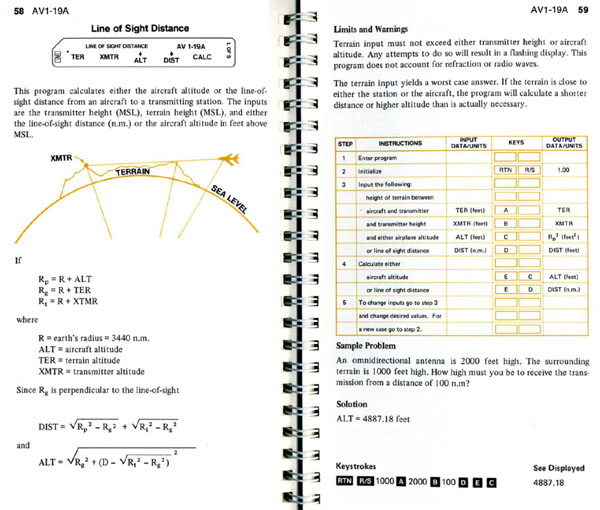 |
| One Among the 29 Programs Solved by the HP 65 Aviation Application Pac |
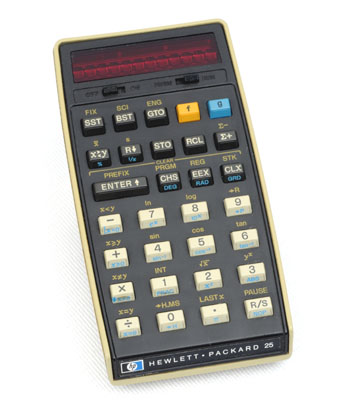 |
The HP 25
|
The HP 25, First Programmable
Low Cost Scientific Calculator
The HP 25 was Introduced in the November 1975 Hewlett Packard Journal as one member in a family of three " second-generation" pocket calculators. This new family had three members, designated HP-21, HP-22, and HP-25. The HP-21 (see below) was a basic scientific calculator that replaced the HP-35, the HP-22 was a business calculator, and the HP-25 a programmable scientific calculator.
The HP 25 contained a sixteen-register data storage chip, newly designed integrated circuit with improved microinstructions and 49 steps of user programming.
The real power of the HP-25 was its easy programming. The programming was based on key phrases rather than keystrokes. A key phrase is simply a sequence of keystrokes that together perform one function or operation. For example, both f SIN and STO + 5 are key phrases, but they contain two and three keystrokes, respectively. The program memory contains numbered locations for 49 key phrases. When the user writes a program, the calculator merges key strokes into key phrases and stores the instructions in program memory.
 |
The HP 21
|
The HP 21,
The HP 21 was the basic scientific model in the second-generation pocket calculator family. It was designed as a direct replacement for the HP-35.
The HP 21 was designed as a successor of the HP 35, with a totally fresh design, taking advantage of late refinements of technology in the areas of displays, integrated circuits, batteries, and assembly. The HP-21, for the most part, uses the architecture of the HP-35 but requires fewer integrated-circuit packages to implement all the functions found in the earlier chip set.
With 33 % more ROM than the HP 35, the HP-21 has all the functions of its three years old ancestor, plus controlled display formatting, polar to rectangular conversions, radian mode in trigonometric calculations, and storage arithmetic.
Other improvements in the objective of size and cost reduction were obtained through the use of a new packaging illustrated in the November 1975 issue of the Hewlett Packard Journal:
 |
"Packaging the New Pocket Calculators" Hewlett Packard Journal, November 1975
Courtesy of the Hewlett Packard Company |
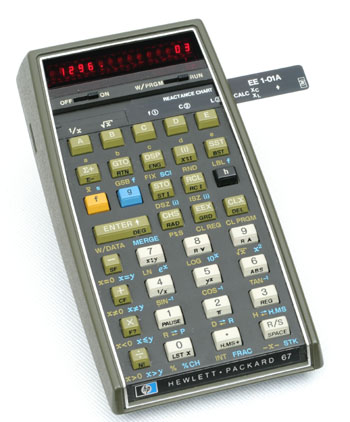 |
The HP 67
|
The HP 67, and HP 97
Rather than a simple HP 65 upgrade, the HP 67 was presented in the November 1976 issue of the Hewlett Packard Journal, with its companion HP 97, as "A Pair of Program-Compatible Personal Programmable Calculators."
The HP 67 was in the tradition of the HP 65, fully programmable and pocket-sized, and the HP 97, a briefcase-portable calculator that had a built-in thermal printer, a buffered keyboard, and a large easy-to-read display. But the most important new feature was that both new calculators were able to read and record programs on magnetic cards using their built-in firmware-controlled magnetic card reader/recorders. Obviously, the same programmable instruction set was used on both calculators making possible to develop and execute program on one or the other, and to transport data from one to the other.
This calculator-pair formed one of the very first solution allowing an engineer to bring computing power from the desk to the field, and reciprocally, the on-field calculation problems, back to the desk for further manipulation and display. However, this concept suffered due to the lack of a transportation media with sufficient data storage space. This opened the road to the development of an interfacing method to interconnect a small transportable calculator with larger and more powerful system. A first step in that direction was the HP 41C introduced in 1980, along with some battery-powered peripherals. The final solution would have to wait until some more developments were available in 1983. Specifically, the introduction of the HP-IL, (Hewlett-Packard Interface Loop) a low-cost, bit-serial interface for Portable Applications. This interface would bring many capabilities formerly reserved for much larger computer systems to the growing repertoire of portable computers and handheld calculators of the era.
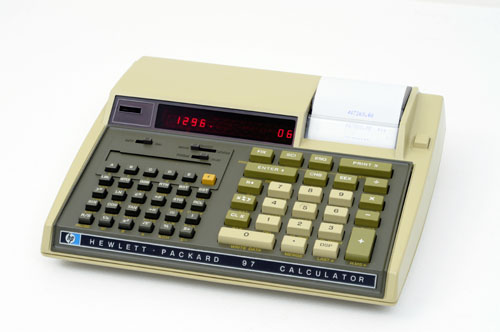 |
| HP 97 |
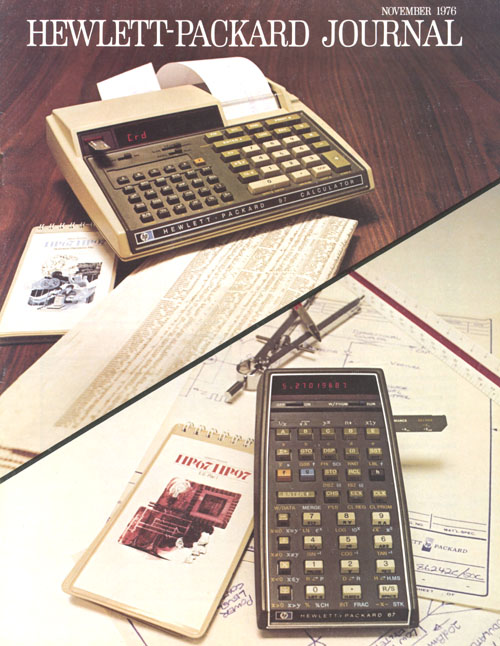 |
Cover of November 1976 edition of the Hewlett Packard Journal
Courtesy of the Hewlett Packard Company |
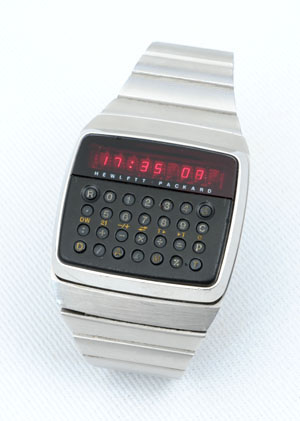 |
The HP 01
|
The HP 01 . . . Code-named: Cricket,
First . . . Last . . . Unique !
Wrist Instrument Opens New Dimension in Personal Information
This was the title of the December 1977 issue of the Hewlett Packard Journal, introducing the six-ounce HP-01, first of a new generation of wrist instruments. And the subtitle followed:
"It's an digital electronic wristwatch, a personal calculator, an alarm clock, a stopwatch, a timer, and a 200-year calendar, and its functions can interact to produce previously unavailable results."
On the technical and engineering side there were many real FIRSTs.
The HP-01's features were made possible by an advanced low-power microprocessor that contains the equivalent of about 38,000 transistors. Extremely low-power circuits had to be developed to achieve a power consumption four orders of magnitude smaller than that of the HP-35, Hewlett-Packard's first pocket calculator. The HP-01's average power dissipation is 20 microwatts with the display off and 36 milliwatts with the display on. Another formidable design challenge was the packaging of six integrated circuits, the display, keys, and buzzer in a volume of about 16 cm3.
In his book "Bill & Dave," Michael S. Malone relates the HP 01 story as follows:
"Designated the HP-01, a singular honor that HP had held in reserve for many years, and introduced in 1977, it was yet one more tiny miracle of HP innovation. Users could pull out a tiny stylus, so well integrated into the wristband as to be invisible, and punch the twenty-eight tiny keys, each of them not much bigger than a pinhead. In an astounding feat of industrial design, HP engineers had managed to stuff six chips and three batteries into this tiny case. The software was just as remarkable: the HP-01 could solve sophisticated arithmetic problems, serve as a stopwatch and two-hundred-year calendar, convert between different measurement systems, even dynamically compute time-based operations on the fly.
At $695 for the gold-plated version, it was expensive, but no more so than the better Swiss watches of the era—and it promised to confer on its owners the cachet HP-35 buyers had enjoyed three years before. HP Corvallis kept the HP-01 hush-hush for maximum impact at introduction, corporate advertising geared up for a major ad campaign, and corporate PR organized in San Francisco the first big new product press conference in the company's history.
When the big day came, the press conference was jammed with reporters. The wire services carried the announcement of the HP-01 around the world. HP employees throughout the company schemed how to get on the short list of discount purchasers of the first HP-Ols to come off the manufacturing line...
... And then, nothing.
The HP-01 never took off, remaining (albeit briefly) an object of admiration, but never a serious subject of purchase. It looked beautiful, functioned superbly, and enjoyed the usual HP reliability. But there were too many reasons not to buy it: the buttons were too small for older eyes, the case was so big that shirt cuffs couldn't be pulled past it, and the HP-01 was so heavy that even HPers joked that it would slowly make that arm longer than the other.
In time, the HP-01 would become a joke, a case study in engineering for its own sake without due consideration for the desires of the potential customer. It would also be a prized collectible on eBay. But in 1977, no one was laughing in Corvallis—or on Page Mill Road."
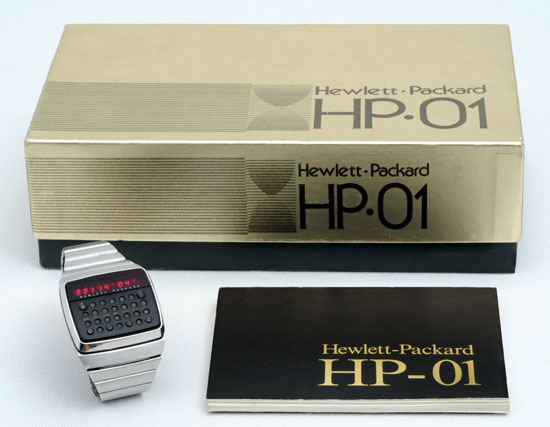 |
| The HP 01 with its Original Box and User Manual |
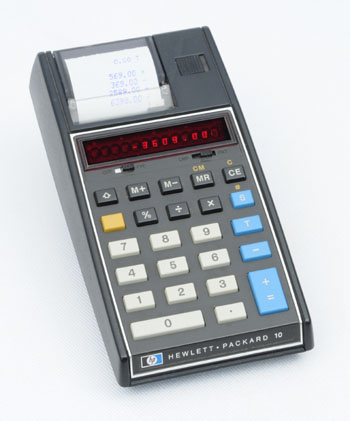 |
The HP 10
|
The HP 10
The simplest HP calculator ever made ! A simple adding machine, performing the four basic mathematical functions, plus a percent function. The only innovation resided in the whisper-quiet thermal printer which gave a valuable printed record of the calculations.
Low cost, ($175 in the 1978 catalog) and printer integration in a pocket-sized calculator, were probably the main reasons to add such a model to the product line. Growing competition in the pocket and hand-held market was perhaps another reason. However, the HP 10 was not a commercial success; it entered the General catalog in 1978, and left it in 1980.
As a result the HP 10, like the HP 01, was produced in relatively small quantities, and these calculators are classified today " rare collector items." Thus, prices are rising and, the last units listed on Ebay have been sold for more than twice their original 1978 prices.
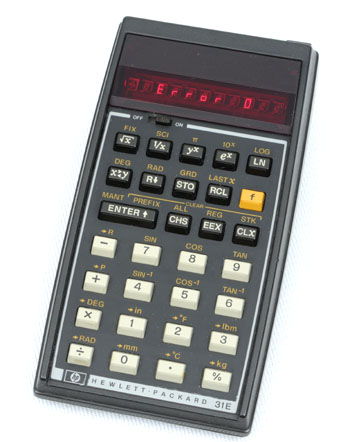 |
The HP 31E
|
The HP 31E, A Third Step Towards Lower Cost ...
...And a third replacement for the HP 35, at the remarkably low price of $60, less than one sixth its grandfather !
Introduced in 1978, the HP 31E was the lowest priced calculator ever offered by HP. It was also the lowest priced member of a complete new generation of hand-held HP calculators for financial and scientific applications. This new family included the HP 37E and HP 38E business models, and the HP 31E, HP 32E and HP 33E scientific models.
All models had larger, easier to read displays than the calculators they replaced. In addition, they were the first HP hand-held calculators with a diagnostic error code system which identified errors made by the user when entering incorrect data.
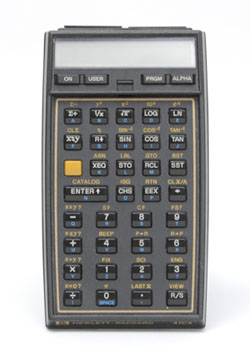 |
The HP 41CX
|
The Next to Come,
Even though it was introduced in 1979, the most important part of the HP 41's life took place during the early eighties. The HP 41C and it's successors, HP 41CV, and HP 41CX will be described in our next chapter, covering the period from 1980 to 2000.
Links to Further Information on HP's Pocket Calculator Product Lines:
The Museum of HP Calculators: By far the most complete collection of HP calculators, plus a huge quantity of information on the how to collect, service, and use them.
The Jacques Laporte Web Site: An in-depth analysis of how they were designed and a considerable work on "The secret of their algorithms".
The Dave Cochran and Tom Osborn Interviews by Steve Leibson. Interview with the men who brought the calculator to Hewlett-Packard
VIDEO |
 |
|



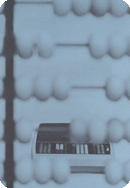

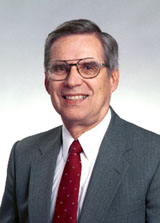



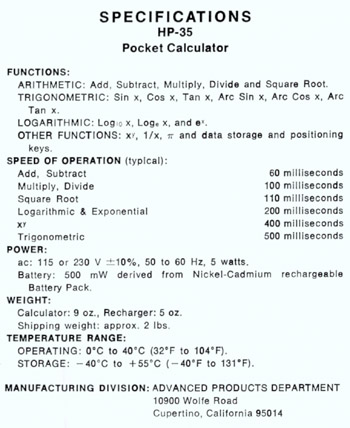



![[Click to launch the HP-35 simulation]](hp35/hp-35.jpg)

















